Sourdough Rye Bagels with Caraway Seeds
Sourdough Rye Bagels are chewy, crusty and properly dense New York style bagels with great rye flavor. They rise overnight so you can have fresh bagels for breakfast or brunch. All they need is a schmear of cream cheese.
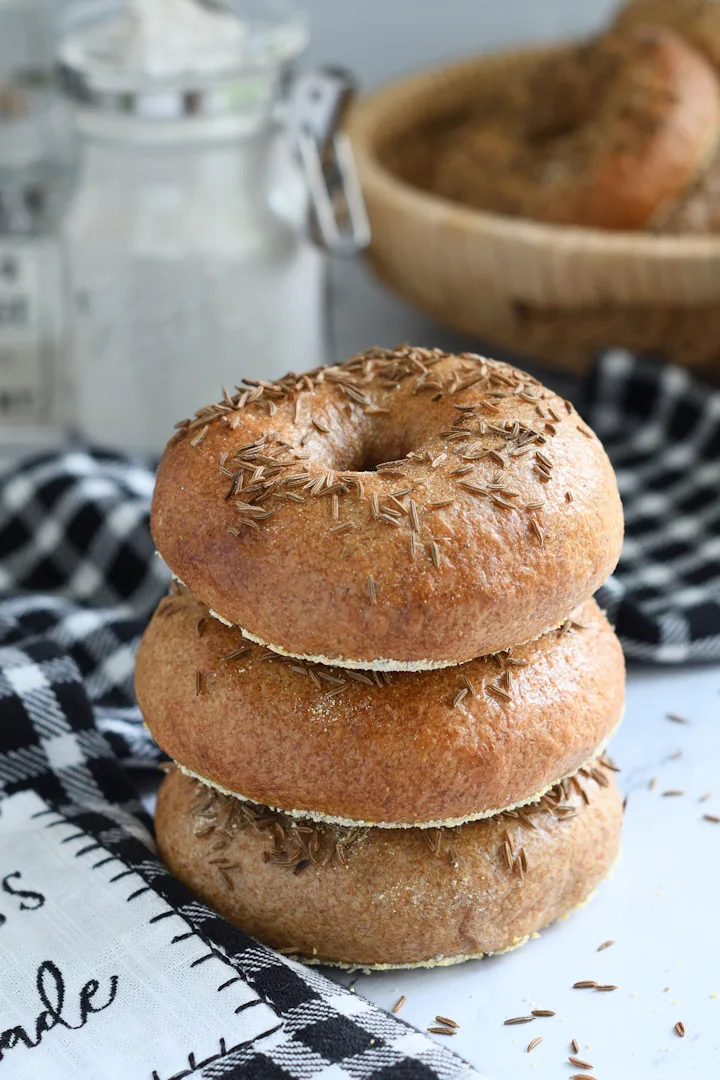
I’ve said it before, I think a good bagel should have a nicely dense and chewy texture with a toothsome crust. Forget the frozen hockey pucks from the grocery store, and the bagels from chain bakeries that are way too fluffy to be a real bagel.
Homemade bagels are not hard to make and they freeze beautifully. If you set aside a little time over a weekend, you can stock up the freezer for weeks to come.
This Rye Bagel recipe is a variation of my popular recipe for Sourdough Bagels. I made a whole separate recipe because I’ve been asked so many times how to make a rye version of my bagels.
If you visit the original post you’ll get lots of additional tips for bagel success and you can read through the many comments and questions about making sourdough bagels.
Scroll through the process photos to see how to make Sourdough Rye Bagels:
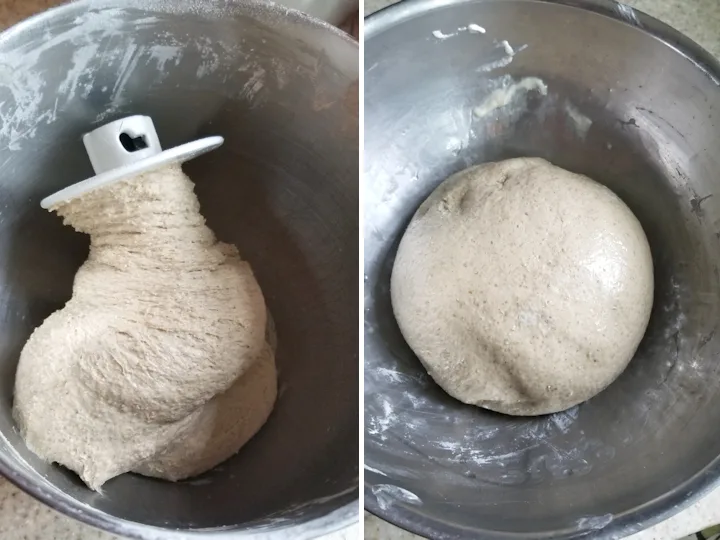
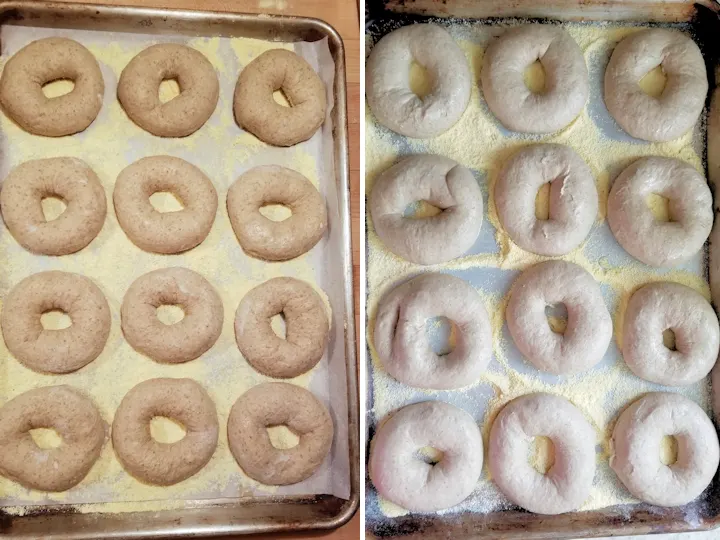

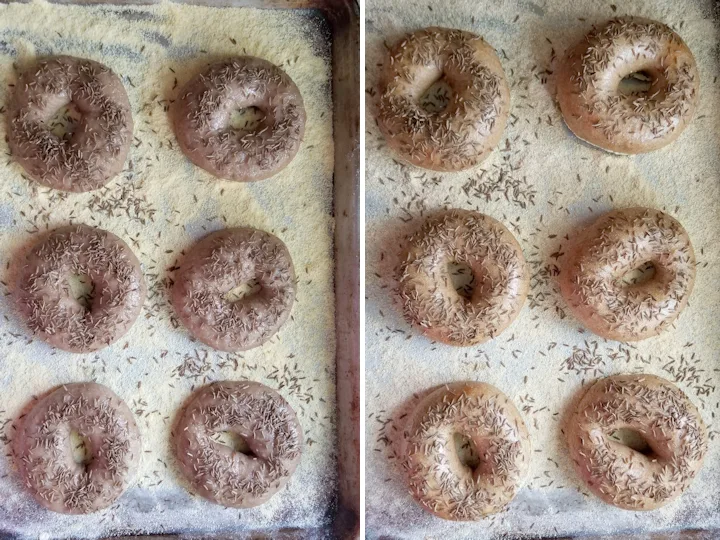
A timeline for making sourdough rye bagels:
- For best results I like to make sure my starter is very well fed and active. I give it two feedings, starting the day before mixing the dough. I do the final feeding with rye flour instead of the usual all purpose flour.
- If you bake regularly with your starter you can probably do just one feeding early in the morning before you mix the dough.
- Mix the dough in the afternoon and you should be ready for shaping the bagels by the early evening.
- In the evening, form the bagels. In cooler months when my starter and dough are less active, I give the shaped bagels 30 minutes at room temperature then put them in the refrigerator for the night. In warmer months when my starter and dough more more active, I put the shaped bagels right into the refrigerator for the night without leaving them out for 30 minutes.
- Take the bagels out in the morning.
- Once the oven is preheated and the bagels are at room temperature, start boiling the bagels.
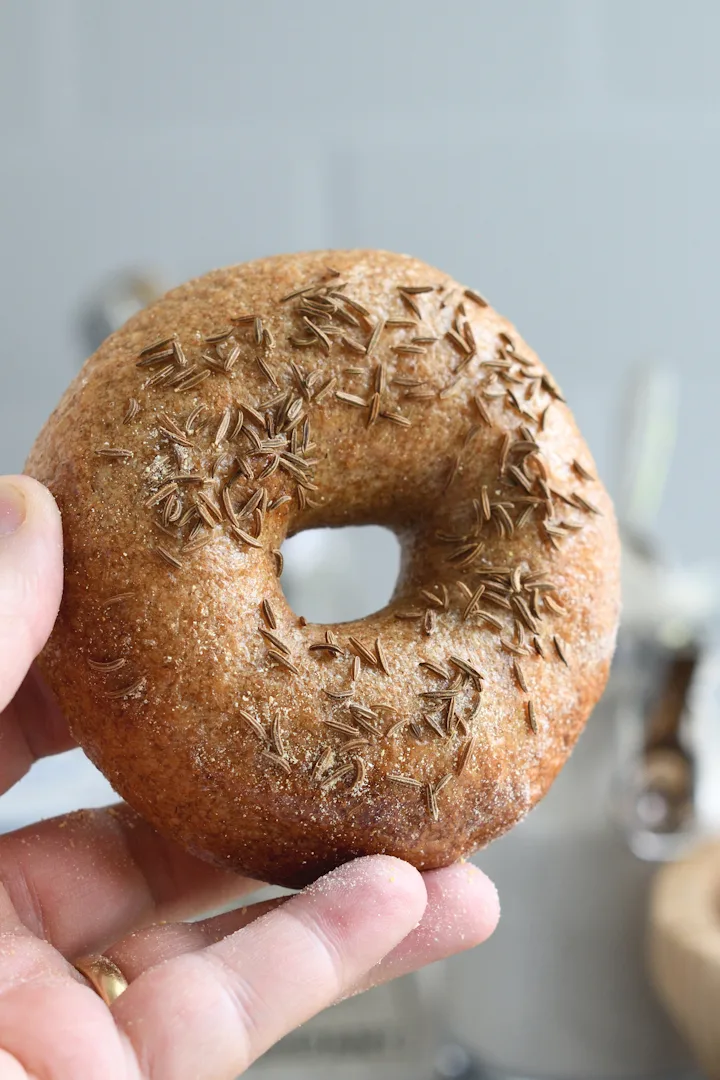
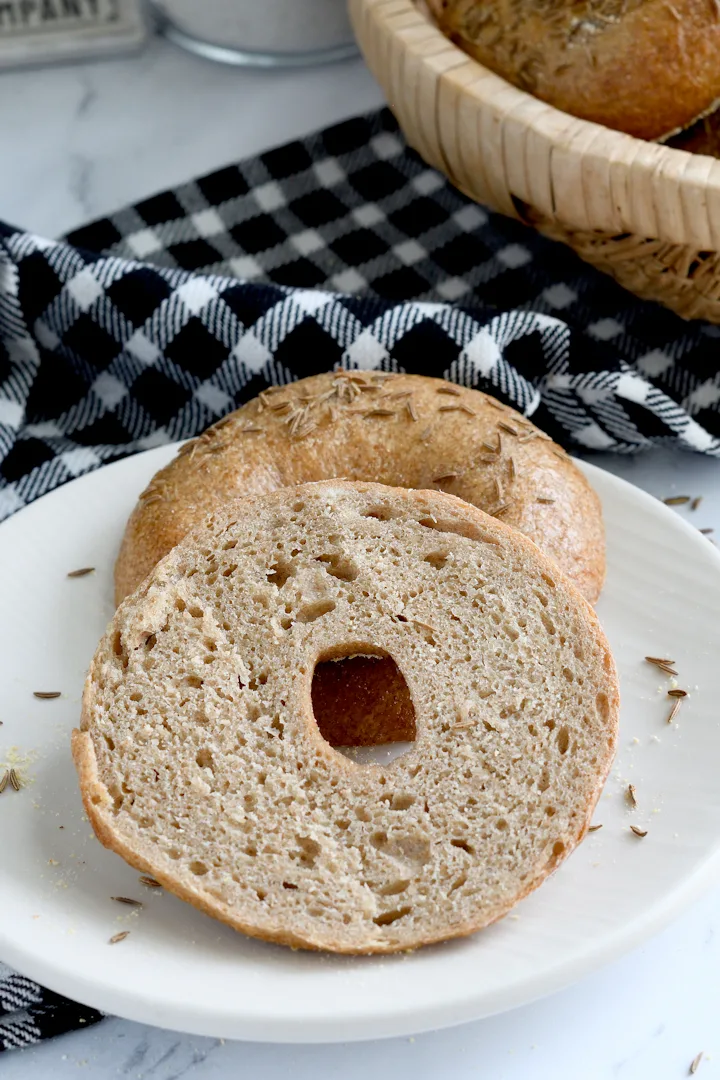
If you love this recipe as much as I do, I’d really appreciate a 5-star review.
Sourdough Rye Bagels with Caraway Seeds
Ingredients
- 8 oz active sourdough starter (1 cup, 100% hydration)
- 12 oz warm water (1 ½ cups)
- 15 oz unbleached bread flour (3 cups, see note)
- 1 ½ oz barley malt syrup (2 tablespoons, see note)
- 1 tablespoon table salt
- 7 ½ oz Rye Flour (1 ½ cups)
- 2 oz granulated sugar (¼ cup, for boiling)
- 2 teaspoons baking soda (for boiling)
- 1 egg white (whisked lightly)
- Caraway Seeds for topping
Instructions
- Combine 8 oz active sourdough starter, 12 oz warm water and 2 cups of the bread flour in a mixing bowl. Mix to form a thick batter. Cover the bowl and set aside for 30-60 minutes.
- Add 1 ½ oz barley malt syrup and 1 tablespoon table salt. Switch to the dough hook. Add the remaining bread flour and 7 ½ oz Rye Flour and mix to combine. The dough should eventually cling to the hook and start to clear the sides of the bowl.
- Knead 5 minutes on medium speed. If working by hand, stir in as much of the flour as you can, then turn the dough out onto a lightly floured surface and knead in the remaining flour. Knead 5 minutes. Form the dough into a smooth ball.
- Put the dough into a lightly oiled bowl, turning once to coat the dough. Cover the bowl and set it aside at room temperature. After 30 minutes uncover the bowl, lift one side of the dough and fold it into the middle of the dough. Repeat with the other three sides of the dough then flip the dough over. You're basically turning the dough inside-out to redistribute the yeast. Cover the bowl and after 30 minutes repeat the procedure. Cover the bowl and after 60 minutes repeat the procedure again. Cover the bowl and after 60 minutes the dough should be ready to shape the bagels. By now the dough should be lively, elastic and airy. If the dough is still sluggish give it another hour or two at room temperature.
- Line a baking pan with parchment paper then generously sprinkle the paper with cornmeal (or flour). Turn the dough out onto a lightly floured surface without kneading out the air. Divide the dough into 10 even pieces. Use a cupped hand to roll each piece into a smooth ball.
- To form a bagel, poke your finger all the way through the center of a ball to make a hole. Use two fingers to gently open up the hole. Continue gently stretching to form the bagel or twirl the dough around your fingers to widen the center hole to 1 – 1.5" wide.
- Place the bagel on the prepared sheet pan and continue to form the remaining bagels. The dough will probably spring back a bit so you can go back and re-stretch the holes once you're done forming all the bagels. Cover the pan with plastic wrap and leave at room temperature for 30 minutes then place the pan in the refrigerator overnight.
- In the morning, take the pan out of the refrigerator. The bagels should have risen a bit by now. Leave the tray out until the the bagels comes to room temperature, about 1 – 1 1/2 hours. The bagels should look full and aerated. They won't puff up and double, but should be noticeably lighter than when they were formed.
- Preheat the oven to 450 °F. In a large pot combine 1 gallon of water with 2 oz granulated sugar and 2 teaspoons baking soda and bring it to a boil. Reduce the heat to keep the water at a rolling simmer. Set a cooling rack over a sheet pan or kitchen towel and place it next to the stove. Line two half-sheet pans with parchment paper or silicone baking mats and generously sprinkle with corn meal (or flour).
- Once the oven is preheated, you're ready to boil. Gently lift a bagel off the sheet pan and lower it into the water, top side down. Boil the bagels for 30 seconds, flip and boil for 30 seconds on the other side. Depending on the size of your pot, you can boil 3-4 bagels at a time. As you remove the bagels from the water, set them on the cooling rack to drain.
- Place 5 of the boiled bagels on each sheet pan. You could fit them all on one pan but they may stick together as they bake.
- Brush the bagels with egg white and sprinkle with caraway seeds. Bake until golden brown, about 20 minutes.
As an Amazon Associate and member of other affiliate programs, I earn from qualifying purchases.









I’m not sure but I was wondering if 1 TABLESPOON of salt was too much for the amount of flour.
Not, it’s not. There are 5 cups of flour in the recipe.
I am currently making this. Just a note of caution to anyone using the servings scaler feature: while the scale feature works for the quantities in the ingredients listing, it does NOT scale quantities in bold on the instructions.
It is very confusing if you are scaling the recipe — especially since the ingredient quantities are not separated for the preferment or levain. Also if you weigh your ingredients in grams.
All the same I am very grateful for this recipe.
Hi Dee Dee, I didn’t realize the bolded ingredients in the instructions don’t scale when you change the ingredients. I’ll check in with the recipe card developer and see if that will be changed. Thanks for bringing it to my attention. I put the amounts in the instructions as a convenience so you don’t have to scroll back and forth with the ingredients.
I’m about to give your recipe a try but I’m confused about the ingredient list notation to divide the flour. I don’t see anywhere in the process instructions to add the flour more than once. Please can you clarify!
Sorry, you add part of the bread flour with the sponge and the remaining after the sponge rests. I’ve fixed it in the recipe.
I’ve made this many times and its a great recipe. Now I’m feeling adventurous and would like to add some pickle juice to replace some of the water. (I read about this somewhere…I think it was for a rye bread). I’m a bit anxious that the acidity will kill the yeast. Do you think it’s a bad idea?
Hmmm, with a sourdough recipe the yeast is a little less hearty than with commercial yeast. I would say it’s a great kitchen experiment to try! Let us know how it works if you do it. If you want to get really geeky here’s a discussion on pH and fermentation.
@Eileen Gray, I got geeky and read the link and now my brain is going to explode. But I did try exchanging some of the liquid with pickle juice and I found the flavor to be very good but it took awhile to get any kind of rise. Now I have to eat a jar of pickles or they will dry out. Lol.
Don’t judge me, peanut butter and pickle sandwiches…
WOW! These are awesome! Baked this am and enjoying them right now! Got approval of the neighbors too! Thank you for great recipes! #lovesourdough
I made the sourdough bagels this week when my daughter was here. She sprinkled on the sesame seeds and I teased her about using caraway seeds, which she doesn’t like. I’m excited to try this recipe! I won’t make them for my daughter though.
I love caraway seeds!